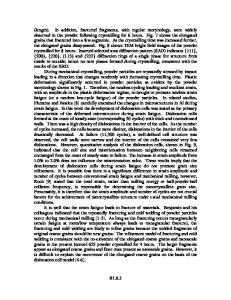Microstructural evolution in sintering of ALOOH gels
- PDF / 4,565,925 Bytes
- 22 Pages / 595.44 x 841.68 pts Page_size
- 105 Downloads / 339 Views
I. INTRODUCTION Several workers in the Materials Research Laboratory at the Pennsylvania State University have been studying various routes to the preparation of nanocomposite materials.' Among these is the purposeful heterogeneous nucleation or "seeding" with the final equilibrium phase of the metastable assemblages obtained by taking advantage of solution or "sol-gel" methods. This article draws together results for the alumina system, previously presented in poster format to the American Ceramic and Materials Research Societies with some additional results and discussion.23 The efficacy of the use of such epitaxial substrates (seeds) in the equilibration of alumina gels at lower temperatures was demonstrated in several studies as early as 1951-1952.4~6 More recent work at higher temperatures on the temperature of a-alumina formation and its effect on microstructure in diphasic A12O3/A12O3 and Al 2 O 3 /MgAl 2 O 4 composites have been reported elsewhere.7'8 The microstructure and transformation kinetics of a-alumina derived on calcination of either boehmite gels or aluminum salts has been variously described and reported over the past two decades.9"14 It has been generally concluded that full densification is inhibited by the generation and/or entrainment of porosity within structures variously detected and described as "aggregates"13 or single-crystal colonies,9'14 which possess a 494
J. Mater. Res. 2 (4), Jul/Aug 1987
http://journals.cambridge.org
vermicular or wormlike microstructure. Enhanced densification has been achieved by various other methods that include ball milling9 and annealing of the xerogel below the observed transformation temperature.12 The transformation of well-crystallized boehmite has been shown to follow the sequence: boehmite (aA12O3 • H 2 O) to y-A12O3 to 5- and
Data Loading...











